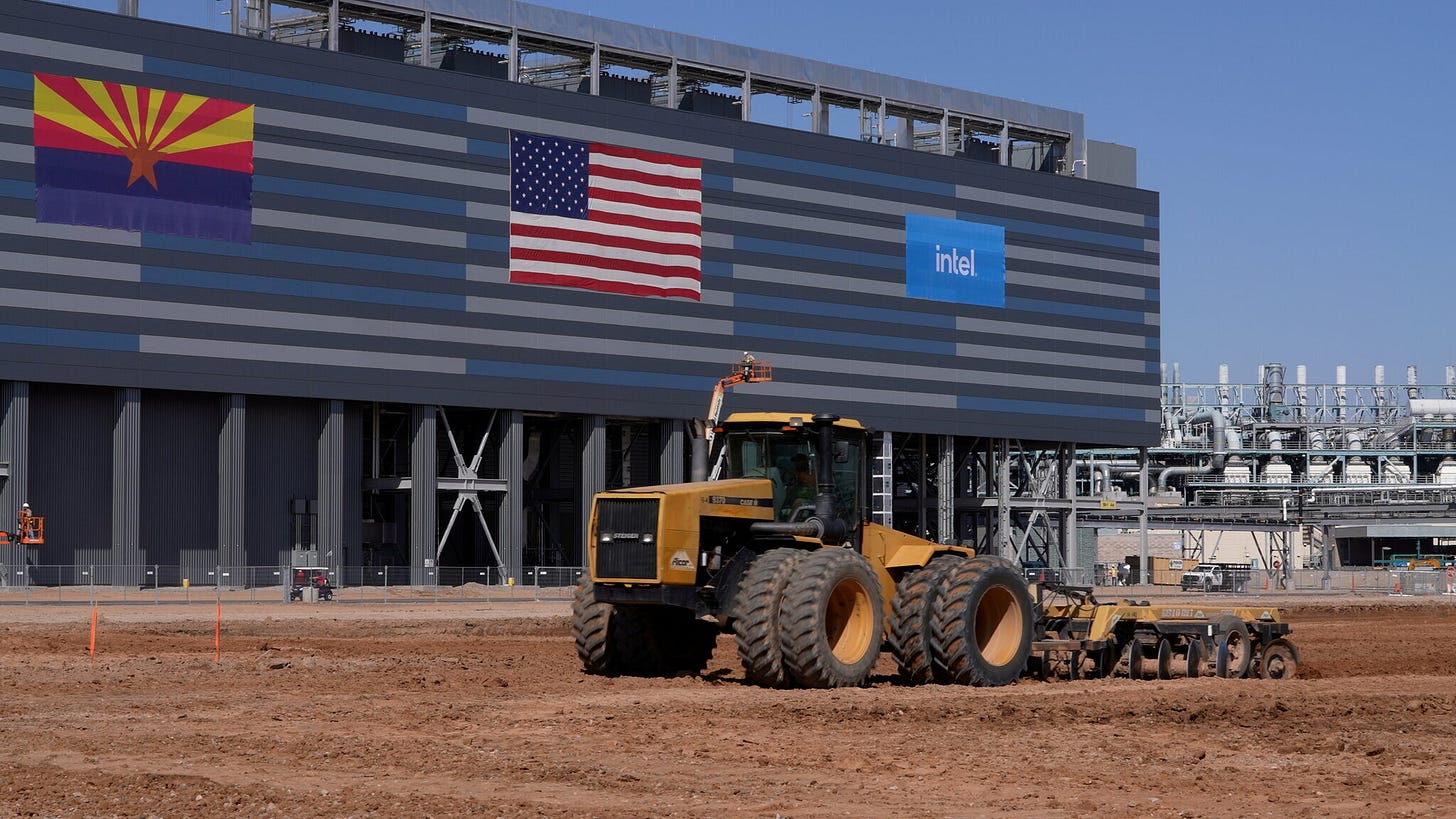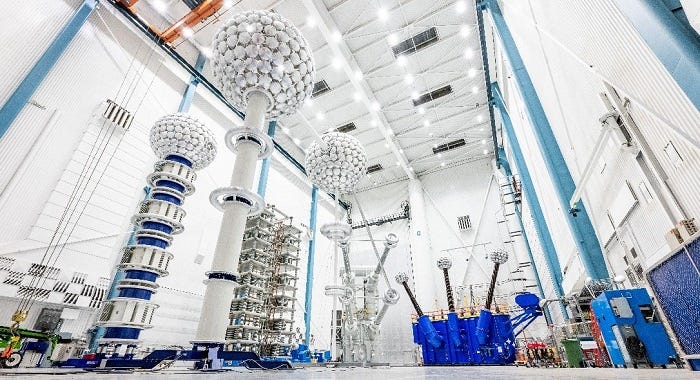HIGH MIX: Just Optimize Everything, Intel On Life Support, Small Modular Reactors
Reindustrialization news for September 8, 2025
Welcome to HIGH MIX, our weekly newsletter about the reindustrialization of the United States.
“‘Innovation Execution’—a new industrial paradigm emerges” MCKINSEY & CO
It’s an interesting puzzle: despite pouring money into fancy tech, many companies aren't seeing big productivity jumps. Why? Because the real bottleneck isn't the tools—it's how we organize work around them.
Let's unpack this McKinsey post.
In essence, they’re saying that the old way of running factories isn't cutting it anymore. New players, especially from China and the U.S., are shaking things up by focusing on super-fast innovation and getting products out the door quickly. McKinsey call this "Innovation Execution," and they argue it's a whole new way to think about making stuff.
In simple terms, it's like going from a slow, predictable bakery that makes the same bread every day to a fast-paced shop whipping up custom cakes on demand—exciting, but it requires a total kitchen makeover.
Contained within their meandering newspeak advice I managed to identify eight proposed big "shifts." Let's break them down into everyday language since McKinsey lays it on thick with the corporate jargon.
"High, or even absurdly high, targets on product and time." This means setting crazy ambitious goals which “act as a forcing mechanism”. Pretty self-explanatory, we’ve all had deadlines.
"Step-change innovation execution across all functions and the entire ecosystem." Instead of tweaking one part of the process, change everything at once. Just try not to throw the baby out with the bath water.
"Customer-back product strategy." Start with what the customer wants, then work backward. For example, a disruptor limiting configurations to speed up production.
"Fundamental research focus." Invest in groundbreaking R&D every one to two years. I got nothing here, folks. Just break new ground, easy-peasy. Why didn’t I think of that?
"Organizational culture geared toward early market launches." Launch products with just the basics, then improve based on feedback. A disruptor focused on software might add features via over-the-air updates.
"Fully involved supply chain." Get suppliers in on the design early. In their example, a Chinese automotive disruptor partnered closely with its supply chain to optimize costs and performance.
"Strategic insourcing." Bring in-house only what gives a clear advantage. Their example was an automotive disruptor who insourced parts where it could cut costs by more than 10%.
"Continuous manufacturing innovation." Keep rethinking how you make things. Gigacasting, used by a U.S. disruptor in their example, reduced variability and assembly time.
This really boils down to McKinsey suggesting factories become more like tech startups—fast, flexible, and customer-focused. In the U.S., where we're trying to bring back jobs and compete with China, this could mean more small, efficient plants that create better products quicker. But it's not easy—it requires changing company culture from top to bottom.
The overall impression I got here was “just optimize everything, bro”.
“'On life support': 3 years after groundbreaking, Intel's Ohio factories still unfinished” THE COLUMBUS DISPATCH
Intel’s $28 billion foundry project is now teetering on “life support” three years after its star-studded 2022 groundbreaking. Originally promising full operation by 2025, the first fab now faces a 2030-2031 opening, a delay stretching five to six years.
Intel’s initial $28 billion pledge, buoyed by $7.865 billion in CHIPS Act funds, envisioned 3,000 jobs and a Silicon Heartland. But financial woes—stock down 57% in 2024, a $10 billion cost-cutting plan—have forced delays, with CEO Lip-Bu Tan admitting the need for “meaningful external customers” to justify the foundry.
Local leaders like New Albany’s Sloan Spalding cling to hope, but skepticism grows—Zach Schiller of Policy Matters Ohio warns it might never fully materialize. The narrative of a triumphant return to U.S. chip dominance feels strained when Intel lags behind TSMC and Nvidia in AI and market share.
Intel’s glaring internal chaos—leadership turnover and China ties (Tan’s investments raise eyebrows)—suggests that there may not be much of a plan here. Perhaps it’s a project more symbolic than strategic.
Prediction: Without an infusion from new contracts, Intel might scale back to one fab, risking $1.5 billion in CHIPS funds if 2028 deadlines slip. Could a partnership with TSMC or Global Foundries salvage this?
“Trump’s Factory Boom Stalled for Now as Payrolls Keep Shrinking” BLOOMBERG
A cold dose of reality: the grand vision of a U.S. industrial renaissance under Trump’s second term is hitting a few speed bumps. Manufacturing payrolls fell by 12,000 in August, marking a fourth consecutive monthly decline—the longest skid since 2020—while the sector has shed nearly 80,000 jobs over the past year.
This data, fresh from the Bureau of Labor Statistics, clashes with Trump’s inaugural pledge of an industrial resurgence, fueled by tariffs and reshoring.
Trump’s 50% tariffs on aluminum and steel, alongside broader trade barriers, aimed to shield domestic producers and spur factory growth. Yet, the market is in retreat—manufacturing GDP has contracted, with 69% of the sector in the red, per the ISM’s Susan Spence.
Tariffs, intended to force companies like Rio Tinto to buy local (as seen in an earlier Bloomberg report we covered), have instead inflated costs—aluminum premiums soared 81% since June to $4,200 per ton—straining downstream industries like auto and construction.
The White House’s optimism about short-term pain for long-term gain looks shaky when paired with a broader jobs market adding just 22,000 in August, pushing unemployment to 4.3%, the highest since 2021.
Weak demand, tariff uncertainty, and a shrinking labor pool are a toxic combination.
Looking Ahead: This stall could continue sans a pivot. Manufacturing output might stagnate at current levels—around 11% of GDP—unless bold moves are made. Using immigration policy as a tool for offsetting skilled labor shortages is a Band-Aid at best.
“Tire giant Bridgestone confirms cyberattack impacts manufacturing” BLEEPING COMPUTER
Bridgestone America, the globe’s largest tire maker by volume, confirmed a breach disrupting production at facilities in Aiken County, South Carolina, and Joliette, Quebec. With 50 plants and 55,000 employees under its North American wing—43% of its global footprint—and a $12 billion sales haul in 2024, the stakes are massive. Bridgestone claims a swift containment, asserting no customer data was nabbed.
This isn’t Bridgestone’s first rodeo—LockBit ransomware struck in 2022, leaking data after a network shutdown. No group has claimed this one yet, but the 57% surge in manufacturing ransomware attacks from July to August (per recent analyses) suggests a pattern.
“Hitachi unveils $1B grid manufacturing investment, including Virginia transformer factory” UTILITY DIVE
Hitachi’s forking over $457 million for a transformer factory in South Boston, Virginia, slated to open by 2028, alongside over $500 million in upgrades across Tennessee, Pennsylvania, and Virginia.
It could be a lifeline for a grid strained by AI data center demands—something we’ve covered before, projected to guzzle 9% of U.S. electricity by 2030, per the Electric Power Research Institute—the plan promises 825 jobs in Virginia alone.
This Virginia facility, the largest U.S. site for large power transformers, will tackle a bottleneck where lead times have ballooned to three years, a crisis flagged by the National Infrastructure Advisory Council’s 2024 call for a virtual transformer reserve. Hitachi’s existing South Boston plant, bolstered by a $250 million global expansion in March, already produces critical components, and the new site will ramp up capacity for high-voltage gear feeding AI hubs and industrial needs.
“US Company Puts Up Fight Against China’s Tariff Evasion” THE EPOCH TIMES
Charlotte Pipe and Foundry Company, a North Carolina stalwart with 124 years of resilience, is a family-owned company making cast iron and plastic pipes. They’re locked in a protracted skirmish against China’s sophisticated tariff circumvention schemes.
Their struggle revolves around a trade war reignited by the 2018 victory over Chinese pipe imports, only to see Beijing’s exporters pivot to transshipment—routing goods through third countries to dodge U.S. duties. With a $40 billion plumbing market at stake and American jobs hanging in the balance, Charlotte Pipe’s defiance offers a microcosm of a broader economic struggle.
The mechanics of this conflict are a labyrinth of trade policy and subterfuge. China’s strategy leverages transshipment, funneling products like steel hangers and automotive parts through nations like Mexico or Vietnam, exploiting loopholes to evade tariffs. This has decimated U.S. competitors—by 2007, all but one steel hanger manufacturer folded under dumped Chinese goods, a trend Charlotte Pipe now combats with vigor.
The Trump administration’s July 31 executive order, slapping a 40% surtax on transshipped goods effective August 7, is a welcome salvo, yet Charlotte Pipe’s Vice President Bradford Muller underscores a critical caveat: enforcement remains anemic.
If you ask me, this sets up a great excuse for a bilateral trade pact with Mexico to close transshipment loopholes, mirroring the USMCA’s China clause. Paired with stronger interdiction efforts by CBP, it would certainly cut down on evasion.
“Why nuclear is now a booming industry” THE ECONOMIST
After decades of stagnation—marked by Fukushima’s shadow and the 2011 shutdown of 54 Japanese reactors—global nuclear capacity is set to grow 2.5% annually through 2035, outpacing the 1.8% renewable surge, per the International Energy Agency. From China’s 27 reactors under construction to the U.S.’s renewed interest with 11 new projects, this is necessity, driven by AI data centers and decarbonization goals.
The shift hinges on innovative tech and shifting priorities. Small modular reactors (SMRs)—compact, factory-built units like NuScale’s 77-megawatt design—are slashing construction costs from $10 billion to $1-2 billion per project, with a 30% faster build time, according to World Nuclear Association data.
In the U.S., companies like Holtec are eyeing SMRs for industrial sites, while France’s EDF plans to double capacity by 2050, banking on 80% nuclear reliability versus renewables’ 30% intermittency.
By 2035, nuclear could supply 15% of global electricity, per IEA projections, cutting 4 billion tons of CO2 annually—vital as manufacturing electrifies.




